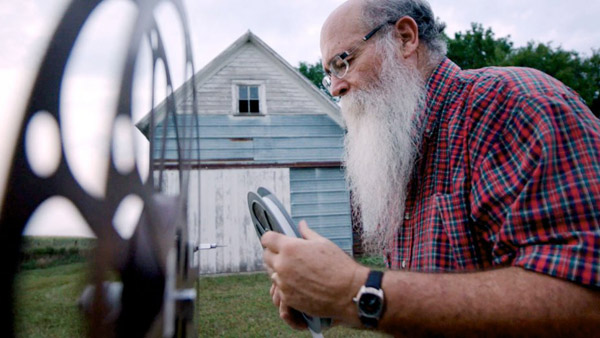The preservation of early silent-era cinema is frequently considered the province of major urban archives or film institutes. But as this highly informative documentary points out, it would be a mistake to conclude that only city dwellers could appreciate the work of a filmmaker like Georges Méliès. As it turns out, not only was an Iowa farmer responsible for saving a large chunk of the French film progenitor’s legacy, but he was only the latest to screen Méliès’s movies in corn country since the late-19th century.
Our introduction to this heretofore little-known slice of cinematic history is Michael Zahs, a longtime collector of Americana, who in 1981 found an extensive number of unmarked film reels in an abandoned shed. He knew enough about the shed’s owner, George Brinton, to assume the films might be significant. After all, Brinton was known to have barnstormed the countryside roughly 100 years ago, moving from town to town, and projecting movies on the sides of farm buildings. But Zahs’s suspicions were not necessarily shared by others, and he spent a good three decades trying to interest somebody, anybody, with a deeper knowledge of film history to check out his find.
Through interviews with the ever-genial Zahs, who gives the film crew a tour of his house, which is near-overflowing with his various collections, we get a recount of his saga to save the Brinton films. One takeaway is just how miraculous it is that the reels survived at all, given how often they changed hands and how many close calls they had to becoming damaged or destroyed. (Someone marked the contents in one box as having nothing of value.) There is also the delicate nature of celluloid itself that could have been its undoing. Luckily, Zahs knew just enough about film stock that he kept the reels in the most ideal spot for them in his home.
His efforts turn him into a veritable folk hero in film preservation circles, and he frequently visits or is fielding visits from archaeologists, historians, college professors, and others who are excited about his discovery. He also regularly checks in on efforts at restoring the Méliès films, which Zahs would like to feature in his own pet project: a reenactment of exactly the kind of picture show Brinton staged. While these two story lines are mostly kept separate, all of the persons involved share a similar sense of excitement about the possibilities that have opened up. By utilizing such a wide canvas, the film becomes a testament to the power of cinema to bring all kinds of people together, from Iowans to other Midwesterners, all the ways to folks from Europe.
As the film spends much of its running time with Zahs, there are countless scenes in which he speaks either publicly or before classrooms, and in every instance his enthusiasm about the past comes through. His tendency to start espousing the history of whatever is on-hand seems downright compulsory at times, as when he visits his mother’s nursing home and starts rattling away about the paintings on the walls. He is something of an odd duck. At one point, he wanders around a cemetery, where he brings the film crew to point out Brinton’s eccentric tombstone, and seems absolutely comfortable there.
Saving Brinton lacks much in the way of suspense, with the only real contention being between Zahs and the preservationists, who may not finish copying every film he would like in time for the Brinton-esque homage he has planned. However, it’s a very genial kind of tension, and the behind-the-scenes look at the art of preservation entails some of the most fascinating scenes. We see, for example, what happens when nitrates have eaten away at celluloid over time or how color-correcting makes the Méliès’s hand-painted cells pop once again. There are also insights into the philosophy behind film preservation—namely, how it’s less about creating perfection than bringing something back to its original state.
By the time of the finale, the film has lost most of whatever forward momentum it had, but at least Méliès’s old works look appropriately stunning. We also come to appreciate Zahs, who despite everything that happens to him, never strays too far from the person we initially meet. Even after a whirlwind tour that takes him to film festivals and even carries him off to Bologna, Italy, for a live outdoor screening in a piazza, he inevitably returns to his small town, his collections, farm, and the legacy of George Brinton that he hopes to resurrect. Once back home, Zahs seems genuinely contented. It’s difficult not to respect that.

















Leave A Comment